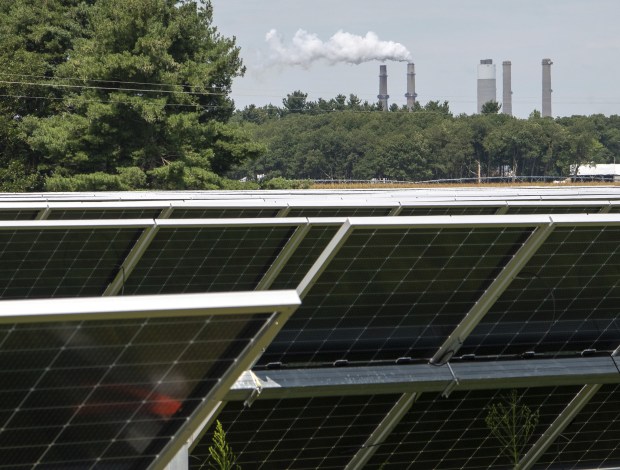As results of a Purdue University study were released, some environmental activists and political leaders say they have concerns about what nuclear energy could mean for the environment.
“It’s cleaner (than coal) but not clean,” Nancy Moldenhauer said. “When we take into account that this nuclear material lasts for millions of years and can kill future generations, it’s hard for me to comprehend.”
Moldenhauer serves in multiple political and environmental positions, including as a Michigan City councilperson and president of Save the Dunes. Michigan City’s existing coal site from NIPSCO was included in a Purdue study that showed small nuclear reactors could present “substantial opportunities” for Indiana, the Indiana Capital Chronicle reported Jan. 8.
Northern Indiana Public Service Co.’s R.M. Schahfer Generating Station is visible in the background of solar panels installed by NextEra Energy Resources in the Dunns Bridge Solar Field near Wheatfield, Indiana on Thursday, August 11, 2022. Schahfer, which is in the process of being decommissioned, was identified as a potential site for a small nuclear reactor facility in a recent Purdue study. (Andy Lavalley for the Post-Tribune)
Small nuclear reactors are advanced nuclear reactors that have about one-third generating capacity of traditional nuclear power reactors, according to the International Atomic Energy Agency.
The Indiana Office of Energy Development funded and released the report in November, and Purdue received $300,000 to complete it, according to the state’s Transparency Portal.
The study found SMRs release carbon-free electricity that have the capacity of Indiana’s growing energy needs, the Capital Chronicle reported.
NIPSCO’s Michigan City location was deemed “too populated” and unsuitable for SMRs. Moldenhauer believes this was the correct decision.
“It’s on the lakefront,” Moldenhauer said about the location. “Some 30,000 people live around that plant, so 100% no nuclear energy should be put in the NIPSCO site here in Michigan City. It’s too dangerous.”
Two of NIPSCO’s other Northwest Indiana plants were included, R M Schahfer in Jasper County and Bailly in Porter County. Schahfer was found to be suitable for nuclear energy, but Bailly was deprioritized.
Wendy Lussier, NIPSCO’s director of communications, said in a statement that the utility is the middle of a multiyear initiative to close its coal-fired generating stations. NIPSCO plans to replace the sites with more cost-effective, efficient and sustainable sources, including wind, solar and battery storage, Lussier said.
Last year, NIPSCO conducted four request for proposal events covering all fuel sources and didn’t receive any proposal for SMR projects. The utility received 116 total proposals, Lussier said.
Kerwin Olson, executive director of the Citizens Action Coalition, said Indiana has no nuclear plants, but state leaders have pushed for nuclear power.
“We intend to be opposed to legislation that we know is coming this year related to (SMRs),” Olson said. “If the nuclear industry does anything well, it’s certainly marketing and propaganda.”
Nuclear energy is the most dangerous, expensive and dirtiest way to generate electricity, Olson said. He’s concerned about the waste, which both Moldenhauer and Susan Thomas, legislative and policy director for Just Transition Indiana, echoed.
Olson also believes there’s an inseparable link between nuclear power and nuclear war, and the construction costs are high.
“(SMRs) are incredibly, incredibly financially risky,” Olson said. “Utility companies would not even consider building (SMRs) or advanced nuclear reactors without the full backing of American taxpayers and ratepayers’ subsidies and incentives.”
Although Olson doesn’t like to say which — coal or nuclear power — is worse, he said nuclear energy poses an “extraordinary risk to the public.”
Sites like Schahfer, Michigan City and Bailly are covered in coal ash, which is a byproduct created primarily from burning coal in power plants, according to the Environmental Protection Agency.
“We’re talking about using sites that are highly contaminated with toxic coal ash and also putting radioactive waste from nuclear reactors on top of that coal ash,” Olson said. “Have we lost our minds? I mean, let’s be real. Communities should be very concerned about the prospect of this.”
Thomas said using sites for nuclear energy wasn’t well thought out. She believes nuclear power is being pushed to fuel artificial intelligence and data centers.
“All of this is a false solution,” Thomas said. “We have real renewable solutions available and at a much cheaper cost.”
Thomas would prefer companies invest in solar power with battery storage, which she said is more cost effective and better for the environment.
Indiana residents have been told a false narrative that we have to choose jobs and the economy over community health and the environment, Thomas said. JTNWI members consider Northwest Indiana to be a sacrifice zone, which is an area harmed by environmental and industrial damage.
“We should not be continuing to use Northwest Indiana and frontline, environmental justice communities as a science experiment,” Thomas said.
Industry has continued to hurt the region’s community health and environment, Moldenhauer said.
“I don’t even think Northwest Indiana should be on the list of considerations,” she added. “For us as a region that has borne the brunt of pollution, I don’t think it’s a wise decision to put anything more up here like that.”
If people are concerned about nuclear energy, Olson recommends they pay attention to statewide legislation and their local governments. Moldenhauer also recommends contacting local officials and state organizations.
Now is the time to participate actively, Thomas said.
“There are plenty of opportunities to get involved, to speak up,” she said. “The time is now before we get steamrolled by this. I realize people are tired and working very hard, but it’s better to be proactive and shape your community than let them be dictated in ways that ultimately don’t benefit us in any way.”




